
Please send all Checks and Money orders to :
Dave Taylor P.O. Box 87 Sylvania, OH 43560
419-842-1863
Click Here to E-mail Us!
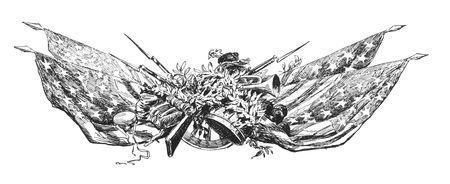

13 06

13-06-01 … 12-06-01 – Highly Historic Double Inscribed Regulation 1850 Foot Officers Sword with Scabbard –
Officer Owner Captured Twice, Wounded at the Salient in 1864, a member of the 14th Brooklyn, the 31st NY, and the Garibaldi Guard!This is the regulation pattern of sword for infantry lieutenants and captains. Slightly curved blade, sharkskin wrapped grip with wire binding, brass guard with floral motifs. This has a beautiful script inscription on the upper mount reading, E.R. / 31st Regiment/ N.Y.S.V. and a matching inscription on the inner guard of the sword as well. (I like this! Some unscrupulous parties on occasion split up this type of double inscription by finding a second unmarked sword and scabbard, switching the parts and creating two identified weapons- its nice to know this sword and scabbard have been together since day one.) Research quickly reveals the owner … The only officer with the initials E.R. in this regiment is Erskine Rich, of the 31st NY, also known as the Montezuma Regiment.
The scabbard is an extra-cost metal scabbard that shows the officer wanted something that would hold up in the field, and is in very nice condition, still showing almost all of the original blue between the brass mounts, which is usually worn or shifted to a plum brown. The mounts are richly engraved on the outboard side with floral motifs, stars on the carrying bands, and an eagle on the drag, as well as the panel for the inscription. Nice mellow tone to the brass. The throat is firmly in place. Just enough wear on the drag to show it was carried.
The grip likewise shows legitimate wear. The wire is in place, and about 40 percent of the sharkskin, the deeply toned wood underneath showing through mainly on the outboard side where an officers palm and fingers would most tightly hold it. The wire is a little raised from the loss of the sharkskin but is tight. The brass shows a good medium tone. The leather pad is likewise in place at the shoulder of the blade. The blade itself shows a few minor finger-nail edge nicks as always, and is a medium silver overall mixed with gray and some dark spots but no rust or pitting and with quite legible floral etching, a US on one side and an eagle on the other with a ribband above bearing the national motto, E Pluribus Unum.
Erskine Rich was born in Brooklyn, apparently came from an influential family, and served in three New York regiments alongside his cousin, Theodore F. Rich. Both enrolled in Co. H of the 14th Brooklyn, otherwise designated the 84th NY at age 19 in New York City in the wake of First Bull Run. Erskine enrolled as a private on 9/9/61 and mustered in to serve three years on 9/13/61. His cousin Theodore signed in the same day. While on picket at Falls Church, Va., both were wounded and captured by the enemy on 11/18/61, and both were paroled on 2/22/62. Nothing like togetherness in a family! Theodore was discharged in April but gained a commission in the 31st New York as First Lieutenant in October and served with it until it mustered out in June, 1863. Erskine followed his cousins lead, getting a discharge for promotion in September and gaining commission also in the 31st NY, being appointed Second Lieutenant in Co. I of the 31st New York 12/16/62, mustering in at that rank 1/13/63, and then as First Lieutenant six days later, 1/19/63. (Cwdata has September date for the commission, but the hard copy of Phisterer says December.)
The 31st was one of the two-year regiments enlisted by New York before receiving the directive from Washington that only three-year regiments were wanted. They had already seen considerable action on the Peninsula at West Point, Va., and Gaines Mill, and were at Cramptons Gap and Antietam. When Erskine Rich joined them they were part of the Sedgwicks Sixth Corps and part of its Light Division. In the Chancellorsville campaign, Sedgwick was to keep the Confederates occupied in front of Fredericksburg, but as Hooker got in trouble in his flanking move up river, Sedgwick was directed to carry the heights above the city by direct assault, where thousands had fallen the previous December, and go to Hookers aid. The 31st was one of the regiments who successfully cleared the town on May 2 and carried the heights on May 3, and pursued the Confederates to Salem Church, where they were brought to a halt.
A member of the regiment picks up the story early on May 3: At about 2 o’clock in the morning, we commenced to form in line of battle. Our right division was given the right of the line to the rear of Fredericksburg, in front of the works where so many of our brave boys fell at the time when Burnside went over. They are the same works that the Irish Brigade failed to take after charging four times. We arrived about daylight, and just as firing had commencedsome of our troops, I could not say which, had been repulsed. Our brigade formed in two lines, the 31st N. Y. and the 61st Pennsylvania in the front, the 43d and 6th Maine in the second line, with the 5th Wisconsin in the front as skirmishers. There we lay down till about one o’clock. In the mean time our batteries and the rebel forts kept a continual firing, and the air was thick with shell and other missiles. Our regiment had ten men wounded while laying here. Well, 1 o’clock came, and up jumped our brigade, leaving our knapsacks, haversacks and canteens behind. As soon as our heads were visible above the hill behind which we had been lying, such a shower of bullets, grape and canister met us that it almost took away our breathin fact it did take away many a poor fellow’s breath for life. Notwithstanding this, the brigade kept steadily advancing, more falling at every step, until we were right into the fort, when all that were there were taken prisoners. You ought to have seen our boys give it to the rebs, while they were skedaddling before we reached the fort. Both our color-sergeants fell wounded, and the colors fell with them. But they no sooner touched ground, than someone else had them. One of our lieutenants took the State colors from a wounded man and carried it safely to the fort.
The Thirty-first’s flag was the first one in the rebel works. Our State color got a whole charge of grape shot through it. Our brigade took seven hundred prisoners and five pieces of the famous Washington Artillery, caissons, horses, and all with them. In this charge our regiment lost ninety-one men killed and wounded … As soon as we were rested we started in pursuit, and came up with them about two miles from the town, where they had more intrenchments, and large reinforcements. Brook’s division were engaged when we got on the ground, and was having a rough time of it, barely holding their own. So our brigade was again formed in line of battle, and advanced to within supporting distance.Luckily for us, our batteries repulsed them just as we came up, and it being then quite dark, we did not push them. During that night the rebels got in our rear and into Fredericksburg. I do not know what they made the next day; we were in front all the time, but were not engaged. That night, when the corps was falling back across the river, our division was left to hold the rebs in check until the force crossed over. Somehow in the dark the rebs got around and surprised us, taking one hundred of our regiment prisoners … You have heard or read of the gallant fighting of the 6th corps. The flying, or light division, did their share of it, but the 31st had the lion’s portion of the fighting in the light division. As usual, I see we get no credit in the papers, at least the Washington papers say nothing about us at all. The 31st is the common talk of the whole Corps, and in our march back to camp the other regiments would sing out, “Bully for the two years’ men!”
The regiment lost 143 men killed, wounded and missing in the engagements. Among them was Lt. Rich, who was captured on May 4. He was apparently paroled not long after, since he mustered out with his company a month later in New York City: the Rebs probably saw no point in holding him long since his enlistment was about up.
Neither of the Rich cousins had enough of army life, however. After mustering out in June, both headed to the 39th New York, the Garibaldi Guard. Theodore mustered into the regiment as a First Lieutenant of Co. F in December, 1863, and a Captain in January, 1864. Erskine followed into Co. F, mustering in as First Lieutenant to replace his cousin and serve under him on 1/22/64. Due to the fact that the 31st Regiment ceased to exist at this time, we can be quite certain that Erskine carried this sword with him into his new assignment in the 39th. There would have been no one to leave the sword with in the old regiment, and he certainly did not need a new sword when he still had this one.
The 39th served in the hard-fighting Second Corps of the Army of the Potomac. The two cousins joined it in time to take part in Grants bloody overland campaign of 1864 that ended with the siege of Petersburg. At the Wilderness the regiment lost 136 men. At Spottsylvania it lost another 132, some of whom were lost in the famous assault on the Salient on May 12, where massed Federal brigades crashed over Confederate entrenchments but were brought to a halt in fierce fighting by enemy reserves. Among the wounded in the assault was Erskine Rich. We have not obtained Erskine Richs service record, but it appears he may have been recuperating from his wound on leave in August, when Theodore was killed in action on 8/25/64 at Reams Station, Va., when Federal troops tearing up the Weldon Railroad were attacked. As senior officer in the company, however, Erskine obtained a commission as Captain of Company F in late December and returned to the regiment. Rich was a popular officer according to the regimental historian, but the Colonel disliked him and there was a blow-up, the Colonel refusing to accept the commission and threatening to have it revoked on the grounds that Rich had gained it through family influence and had extended his leave of absence without permission. Rich threatened to resign; the Colonel arrested him and threatened a court-martial, but Richs papers were in order and the only thing to come of it was ill feeling by the regiment toward the Colonel. Rich served out the war as Captain of Company F, through the Appomattox Campaign, until mustering out with the company 7/1/65. After the war, Erskine Rich worked for a time as a city employee, but suffered health problems and resided for a period at the Soldiers Home in Elizabeth City, Va., later returning to Brooklyn to live with his sister, where he died in 1905. This sword presents very well and belonged to an officer with a long and interesting service record in the war from 1861 to 1865 with the Army of the Potomac.
A superb history worthy of even further research
… $2,850.00 … SOLD
Click Here to E-mail Us!
Call us @ 419-842-1863
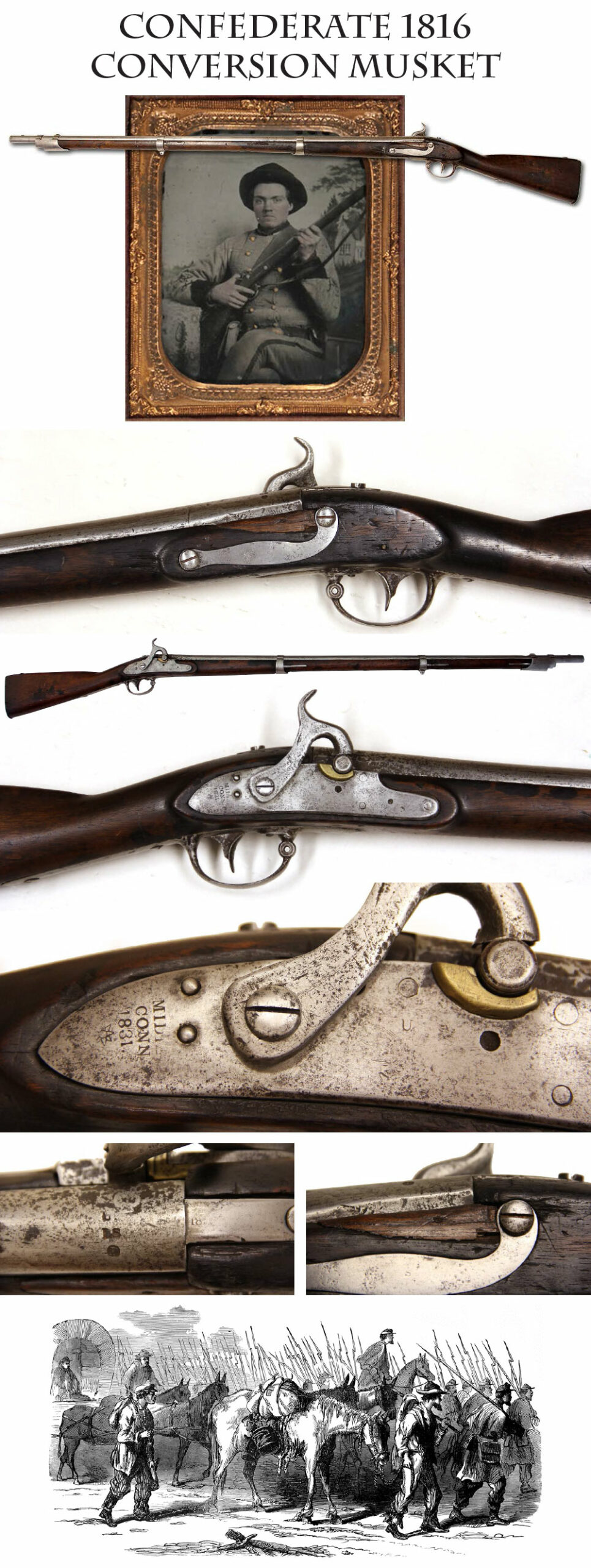
13-06-02 – A Likely Johnny-Reb Confederate conversion of a Nathan Starr 1816 pattern contract musket.
This is as crude a conversion hammer and bolster as I have seen. The musket has been left in its military configuration, not shortened to lighten it up for hunting, or civilian sporting use. The sling swivel mounts are present (though the actual swivels have been removed. Period unknown.) Most significantly, the bayonet lug was retained. In my opinion this is far too crude a conversion for even the poorest Yankee militia company, but it is just the type of weapon dragged out of arsenals and quickly upgraded for service in the South when new volunteer companies were scrambling for weapons in 1861. An incredibly crude flat hammer with exaggerated spur and a simple “drum” bolster quickly brought this flintlock into the modern percussion age. I can’t pinpoint a specific armorer for this, maybe someone out there can, but Southern makers such as Fisher and Hodgkins used flat hammers (though with different bolster conversions), and the Memphis, Columbus and Briarfield armory used the drum-bolster method on barrels. The musket is a Nathan Starr contract dated 1831. Part of the US forward of the hammer is visible and the N of N. Starr. Behind the hammer, MID of MIDDtn is visible, as is CONN, the date 1831, and the 8-pointed star characteristic of the early versions of this gun. Starr made about 15,000 of these muskets and they ended up in the hands of the militia and in armories in many different states North and South. The barrel shows a partially visible barrel date that seems to match on the breech plug tang, and Luther Sage (LS) inspector and proof marks on the barrel. The metal is light gray overall, with some minor firing pitting near the bolster. Springs and bands are in place, but the rod and swivels are gone (easily replaced). The wood has decent color, a mix of dark and medium brown, plenty of dings and marks, but a tight fit around the lockplate. The offside shows more use, with a slight gap along the breech plug tang on top from shrinkage and a replaced piece of wood forward of the upper lockscrew. Oval inspector’s cartouche still visible. This would make a great piece in an early-war Confederate display. A crude conversion, functional and deadly, perfect to display with a huge D-guard Bowie or a rebel canteen. I can’t guarantee that this was used by the Confederacy but I’d bet a dollar against a dime on it. A most affordable “likely Confederate” musket
… $950.00… SOLD
Click Here to E-mail Us!
Call us @ 419-842-1863

13-06-03 – Burnside Carbine Likely Carried in the 2nd Texas Cavalry
Also – Possibly carried in the last battle of the Civil War at Palmetto Ranch, Texas!
The evidence pointing to this carbine being a Texas gun is reasonably good. The serial number 11,162 is nicely sandwiched between known Texas guns bearing numbers of 11112 and 11168 in a cluster of carbines recorded just for Company C of the 2nd Texas Cavalry (US) in May, 1865. Admittedly, being “in the range” of unit known serial numbers is no proof of a regimental connection, but it is a start, and here we have some wonderful visual evidence to help bolster the Texas hypothesis. The trooper who carried this carbine was quite enamored of the five pointed star, incising three such stars on the left face of the butt stock. It is hard to view a carved star on a civil war wood canteen or gun stock and not think of Texas. (Though there is always the possibility that a star could represent the 20th Army Corps.) As for the gun itself … This is the standard model of Burnside issued from 1863 to 1865, sometimes called the fourth or fifth pattern because of the guide screw in the middle of the frame.
This example shows plenty of real field use, with nice saddle-wear clearly visible on the butt stock. There are some rough edges on the fore stock. Barrel color is even brown. Clear and reasonably sharp Burnside Rifle Co. Providence = R.I. markings on the lock. Matching serials on the receiver and breechblock. 1856 Patent marks on receiver slightly light, proofs and Cast Steel 1862 markings very visible on the barrel. Front and rear sights in place, barrel band and sling swivel likewise. Mechanically perfect. Hints of case color (silvery) on sides of receiver. Lever and block are a smoky gray. Wood cartouches are long gone. Butt stock shows the expected dings of active service, and on the inboard side are the aforementioned incised five-pointed stars, 2 lightly done and 1 more deeply. On the offside is a line of period carving, that clearly reads “JM 1864” when the stock is viewed upside down. Flanking the “JM 1864” when viewed right side up is the moniker “MAC”. With this data we might surmise that our soldier was J. Mac-something or J. Mc-something 2nd Texas Cavalry. I can’t
guarantee
the connection but it’s a good hypothesis. The 2nd regiment was composed of Mexicans, Irish, and Germans. I find a James McBirney in the ranks of the 2nd regiment, who just might have been called “Mac,” but there are plenty of other “JM”s in there too. There is much more research that needs to be done. To help confuse matters The 2nd Texas Cavalry Regiment was Consolidated with the 1st Regiment in November 1864 to form a larger than normal 12 company regiment officially titled the 1st Texas Volunteer Cavalry. It served through June 1865. In 1865 the 2nd Texas
Battalion
of Cavalry was organized. The serial number records read “2nd Texas Vol Cav” with a date of May 1865. Does this refer to the old 2nd Regiment or the newly formed Battalion? The remaining research I will leave to you. I have had fun digging out the initial evidence and presenting it. In any case, this is a real field-used carbine that shows wear typical of any gun really carried in action or likely used in the western deserts and plains.
Two companies of the 2nd Texas Battalion of Cavalry were present at Palmetto Ranch in Texas on May 12-13, when Confederates won the last battle of the war. A fine solid Burnside with tantalizing evidence of likely Texas use
… $1,695.00… SOLD
Click Here to E-mail Us!
Call us @ 419-842-1863

13-06-04 … Exceptional Freshly Found Flintlock – Untouched and Attic Dry Early Production 1817 Common Rifle
… likely by R. Johnson with Original Bayonet! I personally pulled this out of a home in southern Michigan where it had been stored forever. Never touched by collector hands. Never oiled. Never messed with. I love these guns that come to us untouched by modern hands. This gun sat unappreciated and ignored … mutely passing decade after decade, existing in storage unmolested through most of the nations history. It passed through wars and elections, existing through 40 of our 44 Presidents, season after season after season passing, and generations of owners sometimes looking at, but likely not knowing nor caring about the story behind the old family gun stuck in the closet, or corner of the attic. Such heirlooms are a rare find in these modern times. This is the 1817 US Contract Rifle, also known as the Common Rifle. It has the untouched attic condition we dream of finding at a farmhouse tag sale. These are elegant guns, iron mounted, finished bright in early production, browned in later, rifled .54 caliber barrels, oval patchbox, brass flash pan and a sweeping lower triggerguard bow that supports the lower sling swivel. These were produced only by a few contractors for the government. They were surprisingly popular, many being converted to percussion and still in service at the beginning of the Civil War. This specimen was never converted. It is still the original flintlock version just the way it was produced nearly 200 years ago. This has an even smooth brown tone overall, deep age patina on the brass pan. Thin crustiness near the breech, loads of untouched crust on the touch-hole, dappled corrosion on the lock mostly forward of the hammer. The gun is sharp showing careful handling and use. The age it exhibits is storage age (rust, dust, and dirt) no abuse or damage. Barrel and lock marks clearly legible, tight wood to metal fit. Stock shows very few handling dings, sharp original edges, and clear ink inspectors cartouche on the left stock flat opposite the lock. The lockplate is stamped deeply with a US forward of the hammer and I see no other marks below it. Robert Johnson is known to have used only a US mark on some of his 1814 contract rifles and I am confident that this is exactly that One of his leftover 1814 locks which he used on his contract with the government for the Common Rifle. The earlier 1814 rifles are very similar in appearance to these common rifles but have different barrel lengths, flash pans, trigger guards, and they carry a bayonet stud. Our gun here has the 1814 style lock with flash pan which slopes forward in the lock, and it also carries a bayonet stud. Both features are a carryover from the Model 1814 and not something seen on most Model 1817s. Johnson had one of the early 1817 contracts in 1821 (preceded only by Deringer,) and was already set up for production from his 1814 contracts. Indeed, he got 260 of his 1817s delivered by the end of 1821. My feeling is that this is likely one of those first rifles. An additional element pointing to an early production date is the presence of the bayonet lug- this was a carry-over from the 1814s, but not specified for the 1817s. In addition – this gun still has the original rifle bayonet on it! A beautiful even plum patina overall, with a small makers stamp near base of the blade. Bayonet Stats: 17.5 overall, 2.75 socket length, 14.5 blade length, .855 inner socket diameter at muzzle. No blood groove in the face of the blade. Has tiny 3/32 square punch stamp dead center in the middle of the ricasso. No other marks. I would wager that this is one heck of a rare bayonet– on the loose this would probably be the subject of long debate among bayonet collectors and be misattributed in the end. It looks like a Model 1816 bayonet but the interior socket diameter is slightly larger. It fits perfectly on the Common Rifle and is sloppy on an 1816 musket. We tend to take rifles for granted as modern arms, but they were a specialized weapon in the early nineteenth century military and they are a very interesting category of US martial arms collecting. You wont get many chances at an uncommon and untouched piece like this. I was ecstatic when I found it and it deserves a good collection for its next home.
It is one of my favorite finds of recent years
… $4,850.00
Click Here to E-mail Us!
Call us @ 419-842-1863

13-06-05 Trapdoor Buffalo Rifle:
A wonderful composite gun made from an 1883 vintage, 45-70 US Springfield Trapdoor rifle with the addition of a sporting barrel and ultra attractive custom hammer, and sights. Serial number on the receiver is 267,042. The breech block is a low arch variety and the tumbler in the lock is a “2-click” type. The 28 inch octagon barrel is totally unmarked, has a finely crowned muzzle, adjustable Winchester style rear sight, and outstanding bore with tight, rapid twist, rifling. The top of the wrist carries an inset steel base engraved with edge lines to which is mounted (by screws) a fine and totally unmarked Vernier tang sight. The stock is fine+ as customized. It has a finely crafted and perfectly fitted German silver nose cap. The wrist is checkered, and the left flat opposite the lock still carries the US Government inspector’s cartouche of “SWP 1883”. The fancy pistol grip style steel trigger guard is well constructed and engraved with edge lines. There is a modern hickory cleaning rod with brass jag carried under the barrel by a single thimble. Condition of this rifle is about fine++. The big question is when the customizing was done. I have examined the rifle quite carefully. The stock, lock, hammer, trigger guard, and Vernier sight base show quite a bit of age. I would judge the age commensurate with the era of Buffalo Hunting. The base for the Vernier sight shows more age than the sight itself. The barrel shows age but not as much as the other parts, leading me to believe that the gun may have been re-barreled again after its’ earlier use as a buffalo rifle. My feeling is that the gun was altered to a Buffalo Rifle in the late 1800s and then upgraded again with barrel and sights in the early to mid 20th century. In any event it is one heck of a nice custom made buffalo rifle. It is one of the pieces I bought from the estate of my late friend Steve Romanoff.
I enjoyed the gun for a while and will now let someone else do so
… $2,250.00… SOLD
Click Here to E-mail Us!
Call us @ 419-842-1863

13-06-06 … 13-03-12 … Quarter plate tintype of Yankee infantryman with musket:
A bit dark, but this Billy Yank stands proudly in a photographers studio in front of a painted backdrop with his bayoneted musket at his side, and wears his forage cap, waistbelt with cap box and cartridge box on its shoulder sling. The photographer lightly tinted his trousers and gilded his buttons and accoutrement plates, which probably cost some extra. Very slight smudge to right of figure. I show an enhanced version of the image as well to give an idea of the content. Rehn, Philadelphia, photographers marking impressed on the embossed velvet facing pad. Scuffing to the leatherette case exterior and the hinge beginning to give way, but a good representative example of the Civil War armed hard image. The case is darn near worth the price of admission
… $85.00
… SOLD
Click Here to E-mail Us!
Call us @ 419-842-1863
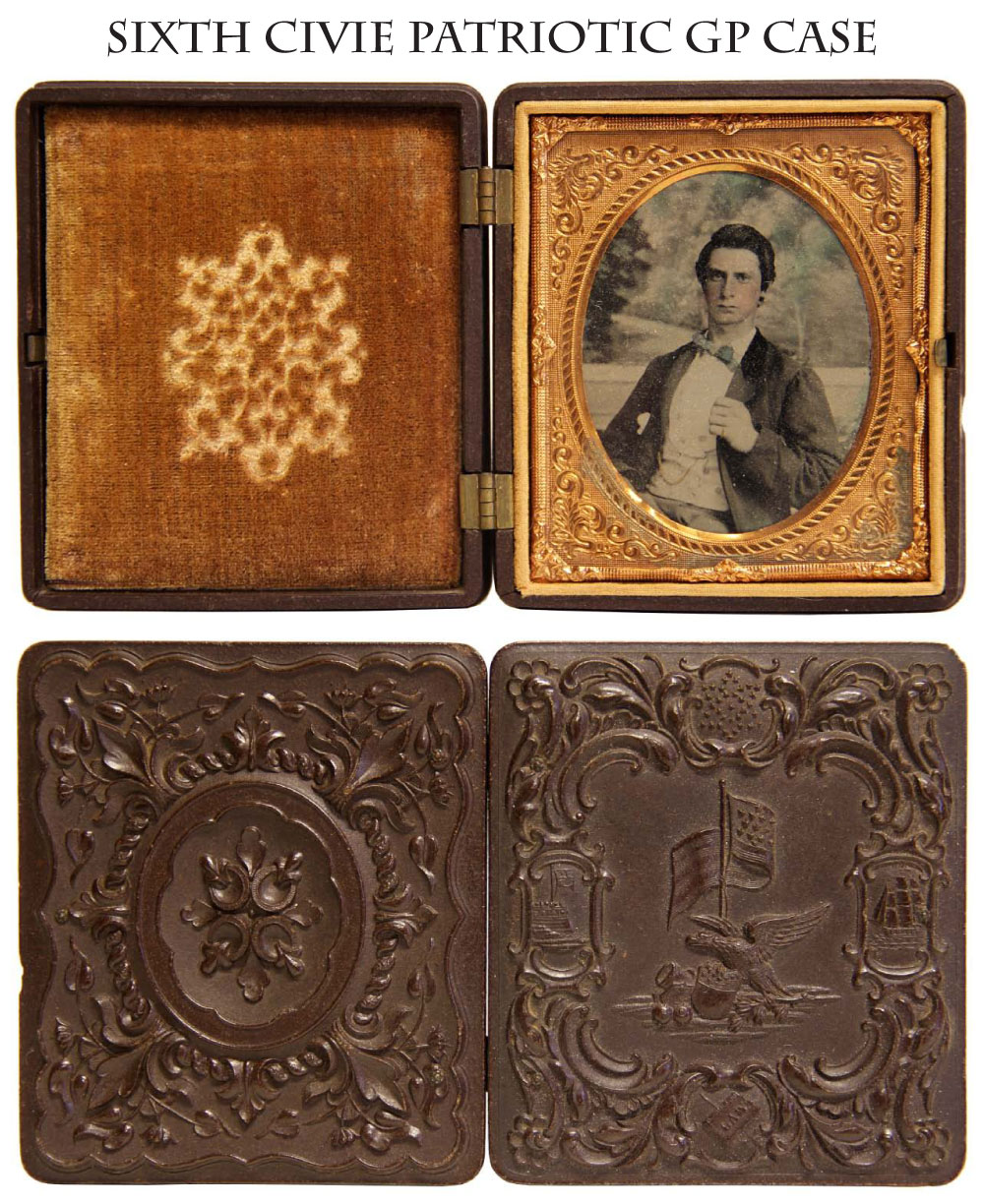
13-06-07 … Nice patriotic sixth plate thermoplastic
(aka Gutta Percha) image case with nice civilian inside
… $200.00… SOLD
Click Here to E-mail Us!
Call us @ 419-842-1863

13-06-08 … 13-03-14 – Patriotic leatherette case and mat housing a noble looking line officer:
The case is separated at the hinge, but bears a wonderful eagle perched on a shield and trophy of arms with a ribband waving above it, embossed on both front and back in an oval on a geometric ground. The inside of the case adds to the motif with a patriotic mat embossed with flags at the bottom and US shields at the top. Our subject is a Union line officer, half length, seated with his hands folded, fatigue coat open to show his dark colored vest, leaning back slightly and gazing up and off to the viewers left with a kind of detached, noble gaze. The folks at home must have loved it. Very appealing image.
$185.00
Click Here to E-mail Us!
Call us @ 419-842-1863
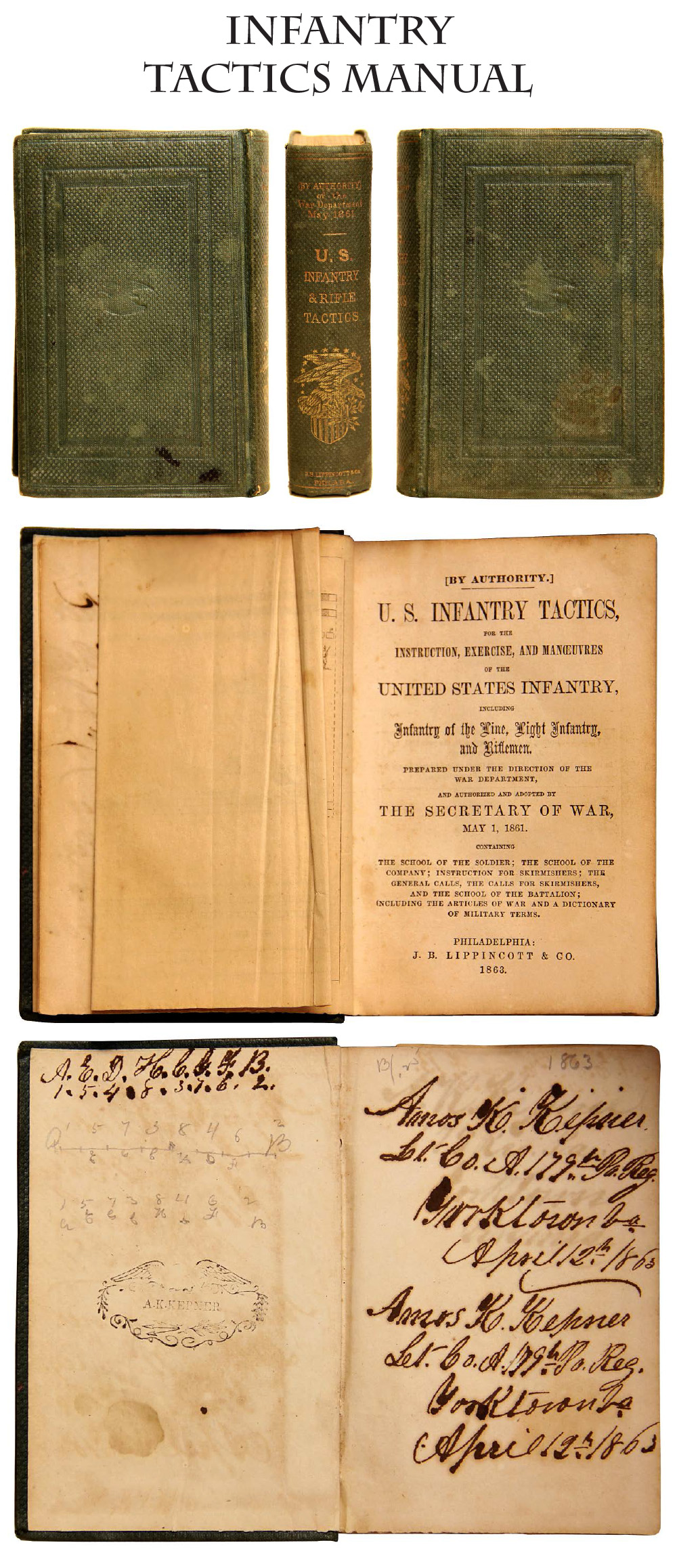
13-06-09 … Pennsylvania and US Colored Troops Officers 1861 Tactics Manual.
1861 US Infantry and Rifle Tactics. Green cloth bound, gilt embossed. Illustrations, diagrams, fold-out plates. Published by Lippincott, Philadelphia, 1863. If you want to know how the Union soldier fought and maneuvered, or how he was supposed to, here is the manual. This is the standard War Department printing of Hardees manual being both volumes printed in one. No mention of Hardee is made as he had cast his lot with the rebs and the USA was not about to give him credit for writing the treatise. Signed twice in ink on the flyleaf: Amos K. Kepner / Lt. Co. A 179th Pa. Reg. / Yorktown Va. / April 12th 1863 and stamped on the flyleaf with his ink stamp A.K. Kepner underneath and eagle. This is the one volume set of tactics that includes the instructions for everything from the school of the soldier up through the school of the company and battalion, instruction of skirmishers, etc. Kepner had a long wartime record. He first enlisted in the 11th PA Militia as a corporal and mustered into Co. G on 9/12/62. This was a thirty-day militia unit enrolled as an emergency measure during the Antietam Campaign, and discharged after Lee moved back into Virginia, Kepner being mustered out 9/25/62. He apparently liked army life, and headed for the 179th PA, a nine-month unit, where he was commissioned in Company A on 11/4/62 and served until mustering out 7/27/63. One company was detailed for service at a hospital and guarding prisoners, Kepner and the remainder were stationed at Yorktown, Va., where he inscribed this tactics book, during the winter of 1862-63 and into July, 1863. That month it joined in the movement made toward Richmond by forces on the Peninsula and took part in two skirmishes, without loss. The men offered their services to the state even after their term was up, but with the end of the Gettysburg Campaign they were mustered out 7/27/63. Kepner again joined the army on 2/26/64, this time mustering in as an enlistedman into Co. F of the 51st PA: a hard-fighting unit. The regiment had reenlisted as a veteran regiment and was recruiting back up to full strength when Kepner joined it. They then joined the 9th Corps, Army of the Potomac for Grants bloody overland campaign of 1864. During Kepners time with them the regiment saw heavy action at the Wilderness, Spottsylvania, Cold Harbor, and Petersburg, and other fights, with significant and frequent losses. It must have been quite a change from his previous experience, but Kepner must have earned some regard in the regiment. He served with them until 11/2/64 when he was discharged for promotion to 2nd Lieutenant in Co. C, 41st USCT, a regiment organized at Philadelphia, and serving in the 10th and 25th Corps in the Army of the James, seeing some action at Petersburg and the Appomattox Campaign, and then being sent to Texas. While with them Kepner was promoted to 1st Lieutenant of Co. F on 5/29/65 and mustered out 12/10/65. He then rejoined the army 4/21/66 as 1st Lieutenant and Adjutant of the 125th USCT during the early turbulent years of reconstruction and served until mustering out 12/20/67. The regiment was organized in Kentucky, but spent some time out west, two of its men being listed as killed in action at Fort Selden, New Mexico 10/23/66. A lot of history tied up in one simple manual. Very fine display item with the super inscriptions
… $250.00… SOLD
Click Here to E-mail Us!
Call us @ 419-842-1863

13-06-10 – 1843 Dated Pomeroy 1835/40 Pattern Conversion Musket with Correct Civil War Bayonet and Scabbard.
Arsenal type cone-in-barrel “Belgian” conversion of an 1840 contract musket. These late production flint muskets went pretty much direct from the contractors to the arsenal racks for conversion and are the typical early war Civil War gun in the hands of the volunteers. This one even retains its bayonet and Civil War scabbard (priced separately). Very good lockplate marks: L. Pomeroy under eagle forward of hammer, 1843 / U.S. to rear. Sharp matching barrel date and US/NWP/P proofs. Very good edges to wood. Crisp cartouches. Metal in the bright, now toning down. Very minor firing corrosion near the nipple. The eagle on the lock a tad rubbed but very visible. Bayonet a nice even brown patina on the socket and bit brighter on the blade where it was kept sheltered by the scabbard. About a 2 inch section of the scabbard seam open, but the scabbard fairly solid. The bayonet was with this gun when I got it, but I will price it with and without the bayonet.
Musket without bayonet
… $1,450.00
Musket with Bayonet
… $1,650.00
Click Here to E-mail Us!
Call us @ 419-842-1863
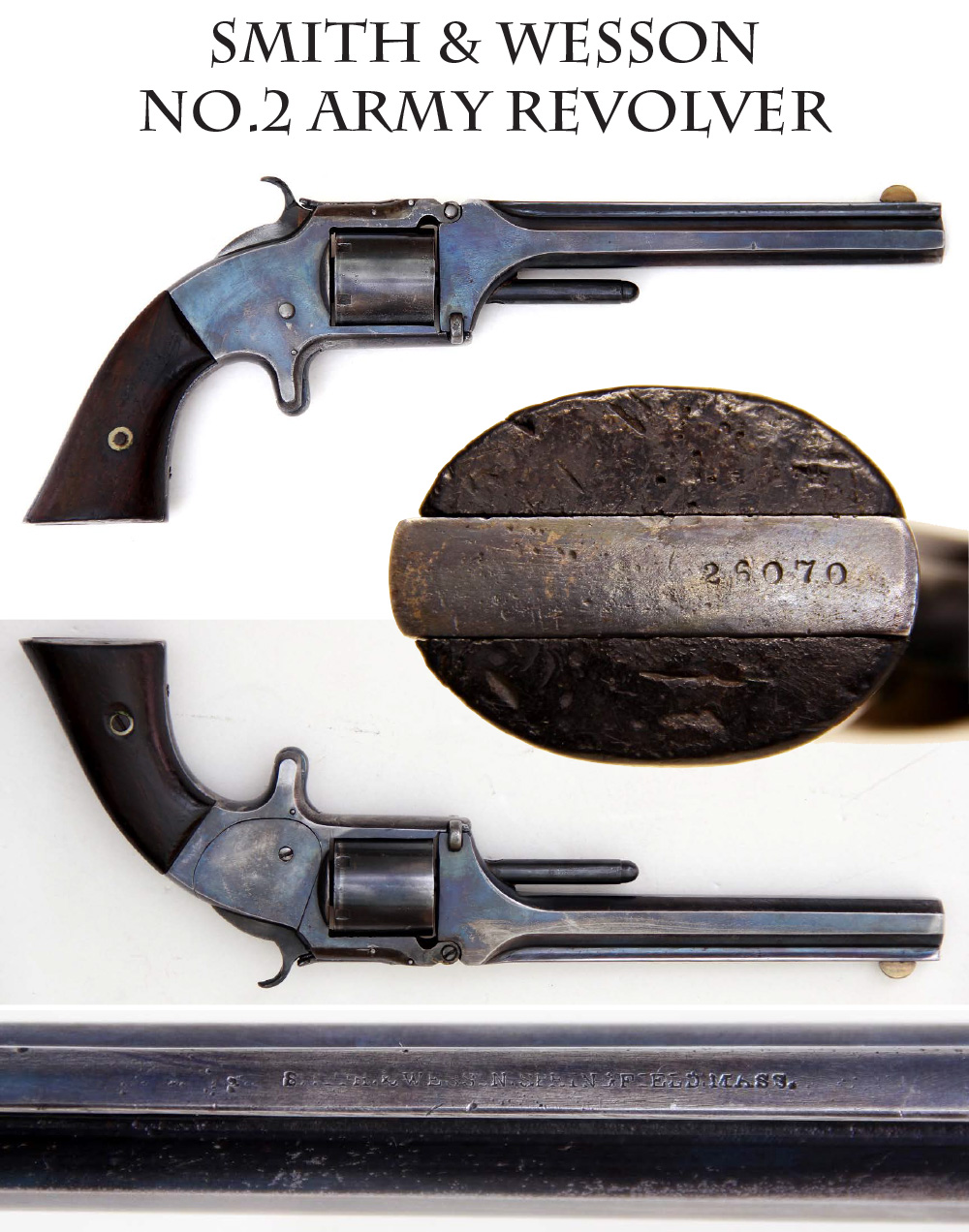
13-06-11 … Smith and Wesson No. 2 Army Revolver.
The classic officers sidearm and soldiers personal weapon. Good mid war serial number, 26,070. (Numbers under 35,000 were produced during the war.) These were favored guns by officers, taking the .32 rimfire cartridge that was not subject to damage by careless handling or wet weather. This one has been wonderfully and properly refinished, the blue being virtually identical to the Smith & Wesson factory finish. very pleasing. The barrel markings show only slight rubbing and no pitting. Grips are good, tight to the metal, and showing just a bit of enlargement at the screw hole, dark, but original varnish is worn. Slight usual ding marks to underside of grips and buttstrap. This display well with an officers effects. They were also a favorite of western travelers and gamblers in the postwar years.
… $695.00
… SOLD
Click Here to E-mail Us!
Call us @ 419-842-1863
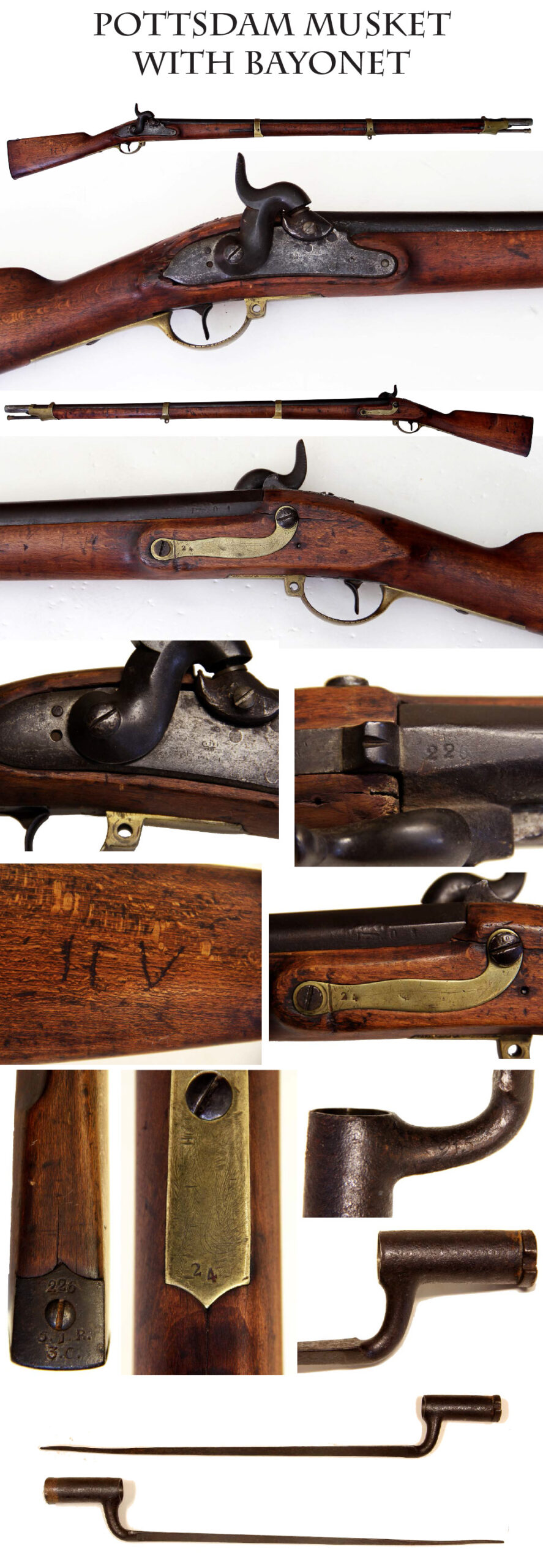
13-06-12 … Early war imported Pottsdam Musket with Bayonet.
These large caliber pumpkin slingers were imported in large numbers early in the war as northern and southern agents combed Europe to find the guns they could not yet produce. The European governments were glad to help out by emptying their arsenals of older models. These brass mounted muskets are classic examples. Showy brass bands and mounts, lighter colored European wood stock. Metal mostly gray, turning darker toward the breech. Slight chipping at rear of lockplate. Markings present on lock but light. Mechanically perfect. Several sets of rack and inspection numbers on barrel and mounts Buttplate shows old German regimental numbers. Light dings here and there. Some salt and pepper pitting on the bolster. A set of initials lightly carved in one side of the butt- most likely a proud American owner. Rod present, sling swivels missing. Still has the correct bayonet that locks on the barrel by rotating to engage a spring clip under the muzzle. Edwards, Civil War Guns, shows a proud old vet seated on his porch showing one off! One of the more affordable early war Civil War muskets.. includes the bayonet!
… $695.00… SOLD
Click Here to E-mail Us!
Call us @ 419-842-1863

13-06-13 … 1/6 Plate, Wearing 2 Four Button Civil War Blouses:
Very sharp tintype of the typical Federal soldier posed in the four-button fatigue blouse every Civil War collector dreams of finding. The most common coat worn during the war, and the rarest coat to find on the collector market. In fact, this fellow seems to have donned two! A second blouse collar and top button shows clearly at his throat in addition to his shirt. This is not too surprising given that even the lined versions of these blouses were not very warm. Our fellow looks squarely at the camera and has scrubbed up for the portrait. Very slight reddish haziness to the background at the upper edge descending slightly to either side of the figure just into his shoulders. Some light scratches, but they only touch his hair slightly at the left and meld into the shoulder on the left. No case, but with mat, glass, and frame and has a good presentation. Have you tried to buy one of these at a public auction recently? There are some crazy prices seen out there. This is dirt cheap
… $59.00… SOLD
Click Here to E-mail Us!
Call us @ 419-842-1863

13-06-14 … Ninth plate tintype of the typical Yankee infantry buck private
in his dress coat and issue cap.
A few small dark spots present but no big deal. The photographer delicately gilded his buttons and put a little light blue to the piping. Very well done. Our boy looks serious- as well he might. There was tough work ahead. Mat, glass, and frame, complete with leatherette case, split hinge, but with red embossed facing pad and geometric impressed motif on front and back. Another affordable CW photo
… $79.00… SOLD
Click Here to E-mail Us!
Call us @ 419-842-1863
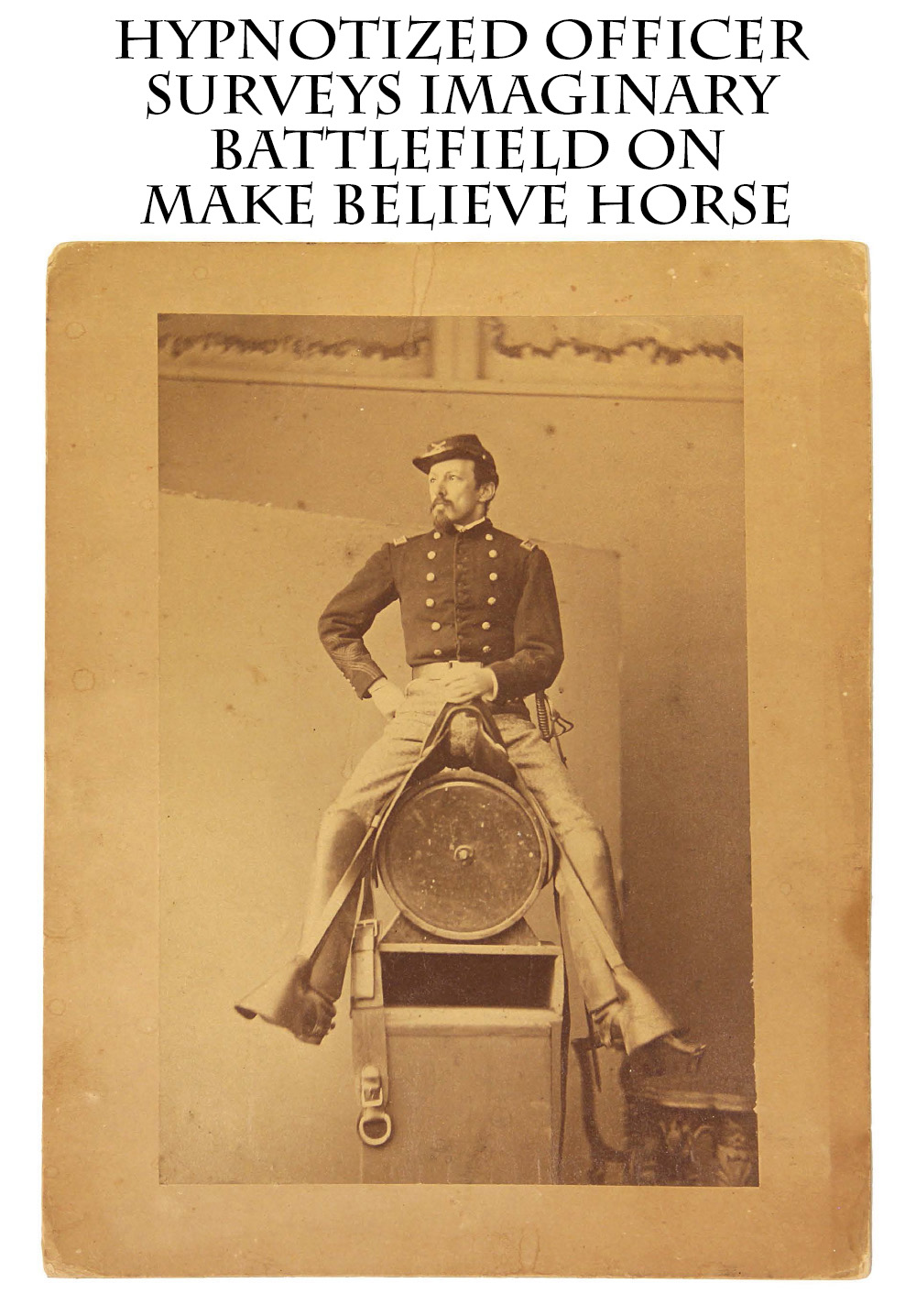
13-06-15 … Mysterious Cavalry Photo – Mounted Cavalry Major:
This image is one of the most unusual I have owned, and has been the subject of many a debate here in the shop. It is a striking and wonderful photo of a US cavalry major handsomely posed seated in his saddle, one hand on his hip, the other on the pommel of his saddle, gazing off to the viewer’s left, wearing his officer’s cap with crossed sabers visible, an officer’s shell jacket with two rows of brass buttons, shoulder straps that appear to have oak leaves at the ends, major’s braid on his cuffs, with saber belt at his waist and his saber with sword knot at his hip. The obvious mystery of course, is why the saddle is strapped to a barrel or keg, resting on a stand in a photographer’s studio.??? The plain backdrop shows behind him, as does the upper part of the studio wall, and below and to the right his spurred boot in stirrup hovers inches above a table. In terms of the “professional” debates here in the shop … One of the I-T guys thinks the officer is comic relief. He came up with our title –
“Hypnotized Officer Surveys Imaginary Battlefield on Make Believe Horse.”
I like that “take” on the image and will allow that such a pose is unique in my experience… making this the rarest Civil War photo of all time. Another of our experts thinks it might be some sort of set up for riding instruction or cavalry training. The chief outside research expert (the smart one in the bunch) thinks it may be an artist’s study photo created for a painter doing a painting of this officer. His evidence??? … A photo published in Military Images magazine of a soldier seated backwards on top of a chair, which is believed to be an artist’s study for a painting of a sentry seated on a rock. In any case, this is a riveting image. I notice the officer’s jacket actually has a single row of dark buttons in the middle of the other two rows. We are possibly looking at a captain recently promoted or breveted to Major who modified his old jacket. I see no sign of a tax stamp on the reverse, and I cannot determine if this is Civil War or early Pre Custer Massacre.
My gut feeling is that it is circa 1866. This too would tend to support the theory that the photo is a Civil War officer posing for a portrait celebrating his wartime career. If one of you has an oil painting of this mounted hero in your collection let us know.
A very cool image in any event. Mount measures 8 by 10, and the image proper 8.25 by 5.5.
This would look great with some cavalry gear and certainly have the visitors talking
… $450.00
Click Here to E-mail Us!
Call us @ 419-842-1863
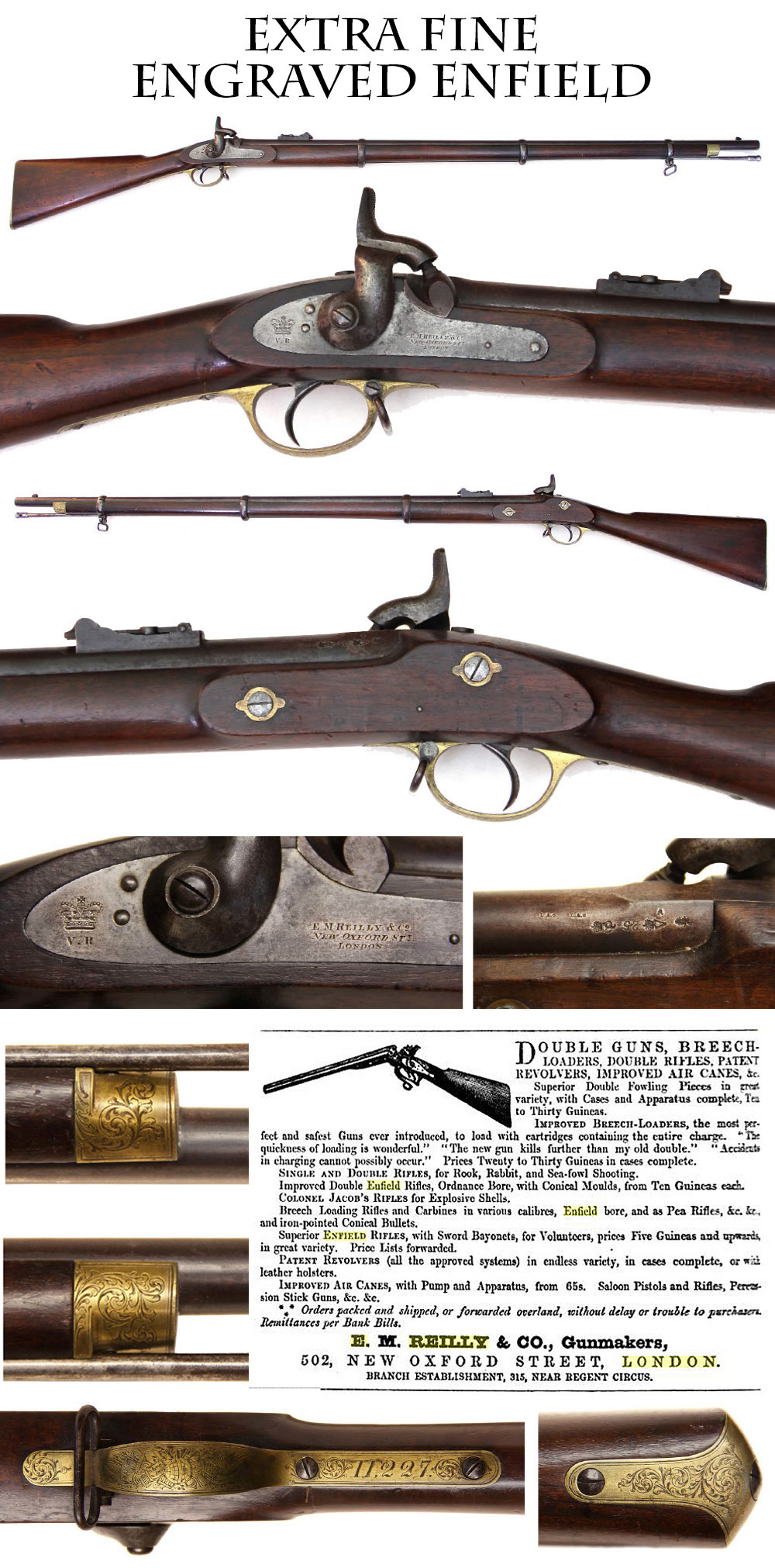
13-06-16 … Wonderful Rare and High Quality Engraved L.A.C. Enfield Rifle Musket ca. 1861:
A true prize… an Extra Fine Engraved example of the P-53 Enfield made by the London Armory Company and sold by E.M. Reilly and Company. Standard military configuration 1853 pattern Enfield signed on the lock E.M. Reilly & Co., New Oxford St., London. Reilly is well known maker and dealer of quality shotguns as well as military arms. He began operations circa 1861 and this musket would date to that time period. Lock also bears a Crown/ V.R. at the rear. Barrel has sharp “25” Bore touch mark (.577 Cal.), inspection ciphers, and “view and proof” marks on left barrel breech. NRA fine to excellent condition. 100% original, 100% complete, and mechanically perfect. Rod, swivels, sights, etc… everything original and in place … All the brass parts are beautifully engraved. The elaborately engraved trigger guard tang has scrolls, floral motifs, and a panoply of arms on the bow. It bears an engraved serial number on the trigger guard tang, and matching scroll floral engraving on the nose cap and butt plate tang! My initial research on this gun revealed that Reilly had some of his guns engraved by the man working next door to his gun factory. I seem to recall that the engraver was his brother in law, or brother … I’ll let you finish the research. Condition is stellar … Tight fit wood and metal, sharp edges on the wood around the lock and to the flat opposite. No damage. Beautiful rich barrel blue about 97 percent, hinting toward plum on the bolster. Smoky faded case on the lock, the hammer showing a little more depth of color. Lock screws show faded bright, other screws have remnants of blue. Rod mixed dull silver and bluish gray. Bands match the barrel, mellow blue with hints of plum. Beautiful walnut stock, just a couple of minor handling dings. This is a magnificent percussion gun, created possibly for an infantry officer or NCO, or a presentation gift, or a prize gun for a marksmanship competition, or a sample gun showing the quality that was available… ??? . The owner, whoever he may have been, was obviously proud of his rifle and took great care in maintaining it. This gun heads out of the narrow world of arms and into the larger world of art. I love being able to offer it, and you will love showing it off. A finer Enfield rifle musket you would be hard pressed to find
… $3,500.00
Click Here to E-mail Us!
Call us @ 419-842-1863

A Pile of Scarce Civil War Production M-1842 Bayonets …
These .69 caliber M42 US socket bayonets with rounded shoulders were produced during the Civil War. Those we see with squared shoulders are the ones made during the 1840s and 1850s. All patterns of this bayonet will fit all patterns of the M1835-40 and M1842 muskets. They are totally interchangeable. These Civil War production examples are by far the rarest pattern. Available here are six very nice examples. All have visible US stampings on the blade. All are complete and functional. Choose from…
13-06-17A and 13-06-17B…
NRA very good + condition. Light wear. (qty2)
… $265.00
13-06-17C (SOLD) … 13-06-17D and 13-06-17E…
NRA fine condition. Sharp edges. (qty3)
… $295.00
13-06-17F …
NRA fine condition – blade shortened to 14”
… $100.00
Click Here to E-mail Us!
Call us @ 419-842-1863
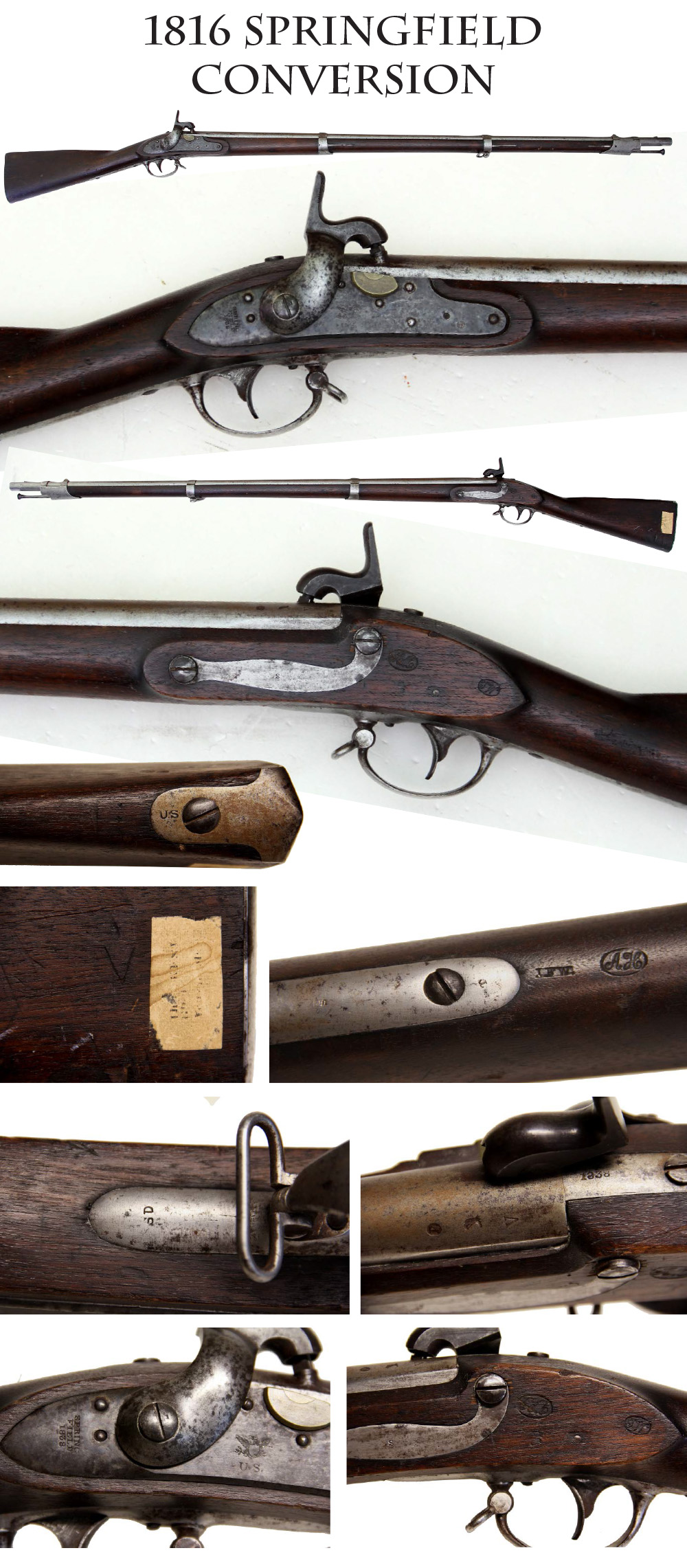
13-06-18 … 1838 Dated 1816 Pattern Springfield Conversion Musket.
As with the Pomeroy musket I offer elsewhere on this list, here is a gun typical of those issued early in the war to the rush of men anxious to defend the Union. When the percussion system was adopted, the government inspected all arms on hand, dividing them into classes according to condition and suitability for conversion to the modern percussion system. Here is an 1816 Pattern made at Springfield in 1838 that was deemed worthy of conversion and re-issue, and still rates about fine condition. Very clear Eagle/US forward of the hammer and Spring/field/1838 to its rear. Matching barrel date. Sharp view and proof marks on left of barrel at breech. Sharp inspector cartouches in the wood opposite the lock and the rear of trigger guard tang. Rod, bayonet lug, bands, swivels all in place. Nice even dull steel tone on metal, not polished up to beat the band. Sharp edges on the wood and nice tight wood to metal fit. Some darker spots near the nipple, but not corrosion, good nipple. Hammer showing mottled dark gray faded case, lock likewise with some smoky blue undertones. Sharp smooth surface to the lockplate where they ground it off as part of the conversion, which is the typical arsenal cone-in-barrel type. A faded paper label on the butt stock may have contained an historical note but I cant make it out. It was on the gun when I bought out a local collection. I see a very light V carved in the wood next to it. A nice example of gun illustrating US arms development and Civil War weapons, and a Springfield to boot
… $1,195.00… SOLD
Click Here to E-mail Us!
Call us @ 419-842-1863
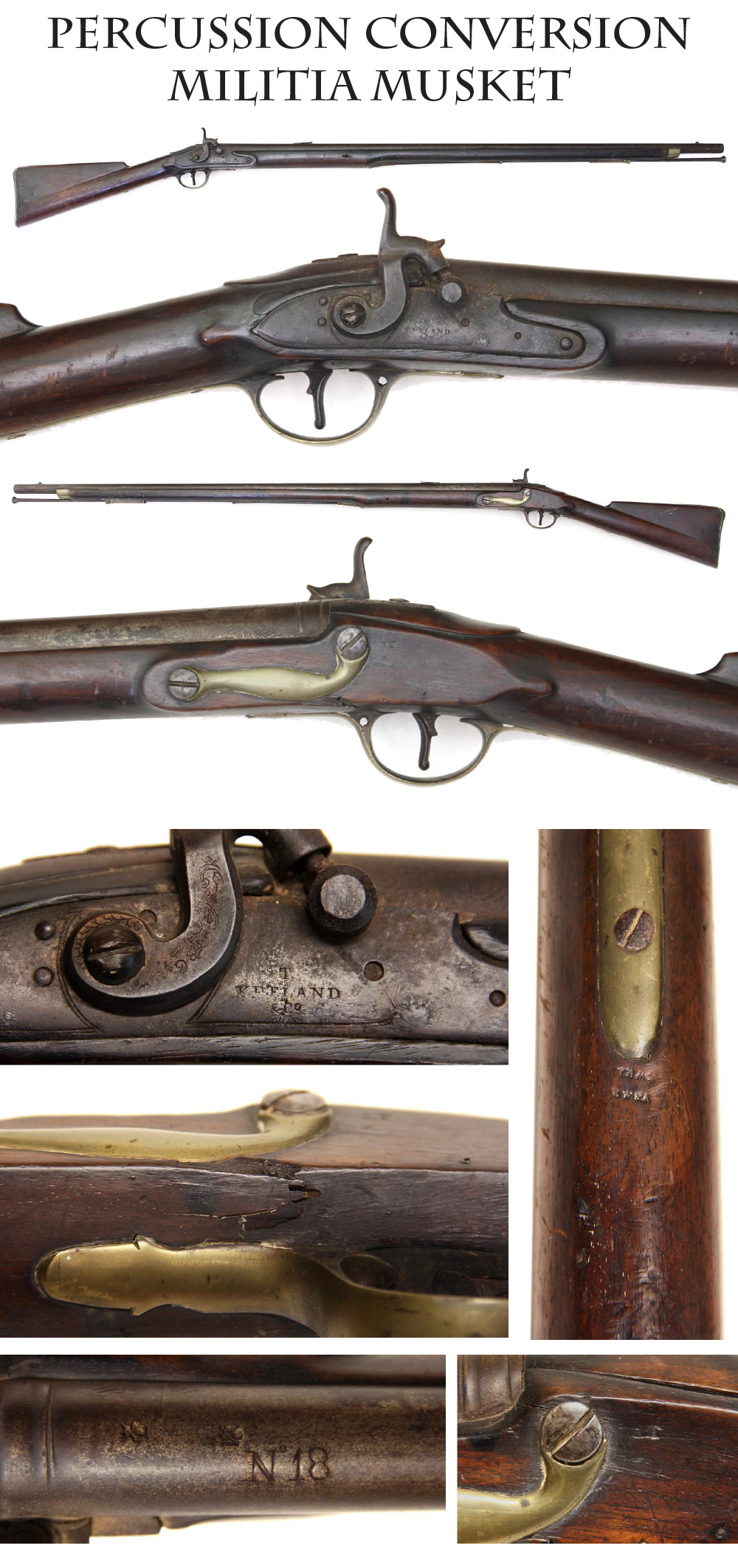
13-06-19 … Percussion conversion militia musket.
Elegant English militia musket, Ketland lock, originally flint, converted probably in the 1830s to percussion by a competent gunsmith using a side-drum, or side-lug bolster, and a shapely civilian style hammer that is nicely engraved with floral motifs. Classic British style stock with prominent handrail, teardrop carving at rear of lock plate and beavertail raised area around the breech plug tang. Set up for sling, but swivels missing. Convex elongated-S brass escutcheon side plate. Retains all three ramrod thimbles. Has button-head rammer, brass nose cap, top mounted bayonet stud/sight. Light baluster rings at breech, view/proof marks top left of breech and larger No. 18 rack number engraved at center just forward of proofs. Even gray/brown tones to barrel with some areas of bluing showing. A little crustiness on barrel and lock near the nipple from firing, but not bad. Slight crack showing below side plate, next to trigger guard. A couple of small sets of initials stamped in wood on offside and near trigger guard tang, possibly inspector or stocker. A nice gun. Looks very much like an officers fusil, but with the rack number on the barrel I feel more comfortable calling it a militia musket. This style was in use 1810 through 1830s. The architecture of this stock with the long thin wrist would tend to indicate the earlier part of the period. These are elegant weapons and I think they are underpriced in the market. Such anomalies are the collectors best friend. A lot of history for the money
… $795.00
Click Here to E-mail Us!
Call us @ 419-842-1863

13-06-20 … Starr Carbine: Ebenezer Starr was the son of famed gunmaker Nathan Starr
and developed this single-shot .52 Caliber breech loading percussion carbine. Brass mounted with single brass barrel band and brass butt plate. Sling ring fixed on the left side by a sling ring bar in the receiver. Combination triggerguard/lever lowers the breechblock for insertion of the cartridge. This carbine rated higher than the Sharps carbines in government tests, but history has graced Sharps with the magic name and few present day people have ever heard of Starr. In any case, the Starr was pretty widely used, about 20,000 were made, and units such as the 1st Arkansas, 9th and 24th New York, and the 17th Penna Cavalry regiments had them. This one shows signs of real field use: you can see where the sling ring pushed against the wood while a trooper carried it slung from his sling while mounted. Barrel shows a deep old oxidized blue with light pitting scattered about and some dark areas coming through. Legible barrel marks. Rear sight and leaves firmly in place. Mechanically perfect. Sharp Starr markings on lock and receiver. Receiver shows usual mottled gray/blue of faded case colors mixed with gray areas. A little brown crustiness on the upper tang from firing. Forestock very good with decent edge and tight fit to metal. Butt stock shows cartouches at wrist but dents from the sling ring, a number of minor dings and scratches elsewhere. There is a major chip of missing wood at the toe of the butt caused from careless handling – the trooper let it hit the ground too hard. Exposed wood has a dark patina, so its an old injury that could be easily and invisibly fixed, but I have elected to leave it as is since it is likely a wartime blemish. Nice patina on the brass, and a must-have carbine in a Civil War cavalry collection. Most affordable
… $1,395.00… SOLD
Click Here to E-mail Us!
Call us @ 419-842-1863

13-06-21 … True Steel Canvas! Deluxe, High Art, Engraved Merrill Carbine!
Without question the finest Civil War carbine I have ever owned and a peer of the finest engraved carbines known to exist. What a smoker of a gun! I couldnt take my eyes off this when I saw it at the recent Colorado Gun Collectors Show and I would have climbed over a crowd three-deep to get at it. This is a magnificent gun: 90% luminous barrel blue of a quality far surpassing standard blue blue dissipates at the breech matching finish on all the other metal parts and wood. Stock is near mint with finely checkered wrist and edges so sharp you could cut yourself. Profusely engraved and bearing a steel patch box and barrel band instead of the standard brass. Profuse quality engraving is found on the lock plate, trigger guard, patch box, butt plate, sidebar supports for the sling ring, the hammer, bolster, and loading lever as well! Panels are bordered by small dappled triangles and the central sections are filled with lush vine scroll engraving and roundels. The patch box is beautifully contrasted by the deluxe grade wood and is filled with vine scrolls and a round ten-spoked pin-wheel/flower motif that mirrors a swirling flower at the end of the lever latch. Especially impressive is that instead of the usual brass mounts, Merrill used steel on this gun, which is a much more difficult medium to work in. They succeeded in producing a magnificent work of art in this 1860 carbine. There are generous traces of silver finish on the steel. Hammer, lock, receiver, and loading assembly show the faint cloudlike grays that come from faded case colors. The sling bar mount shows traces of blue. The wood around the patch box has a lovely burl pattern … deluxe wood. Merrill did not mark the lockplate with the usual maker marks of his military contract guns, but did keep his patent information on the loading lever assembly in a bordered rectangular panel. I see a little graying on the side of the loading lever assembly, and there is one slight track in the wood above the side bar from the sling ring, but thats about it for fault-finding on this piece. Back in the old days one of the early collectors used to display his collection of engraved Merrill Carbines. I always marveled at them and wished I could find one. I guess it took me the better part of a lifetime to accomplish the task. Merrill was in the arms business in Baltimore starting in the 1840s and took up military arms around 1855, marketing his carbines and converting Jenks carbines and Mississippi Rifles to his system. He submitted this pattern carbine to the government in 1860, improved it, and supplied about 14,500 for the war. This deluxe engraved gun may have been made for a high ranking officer, or as a gift to a US government official in hopes of obtaining a favorable contract, or perhaps made for display in an exhibition. This represents a one-of-a-kind opportunity for the collector. There is not a similar gun in the book Steel Canvas, but if the author had known about it, it would be there! A magnificent gun. I cant praise it enough …
I paid a bunch for it and I want a bunch plus a little bit
… $16,000.00… SOLD
Click Here to E-mail Us!
Call us @ 419-842-1863
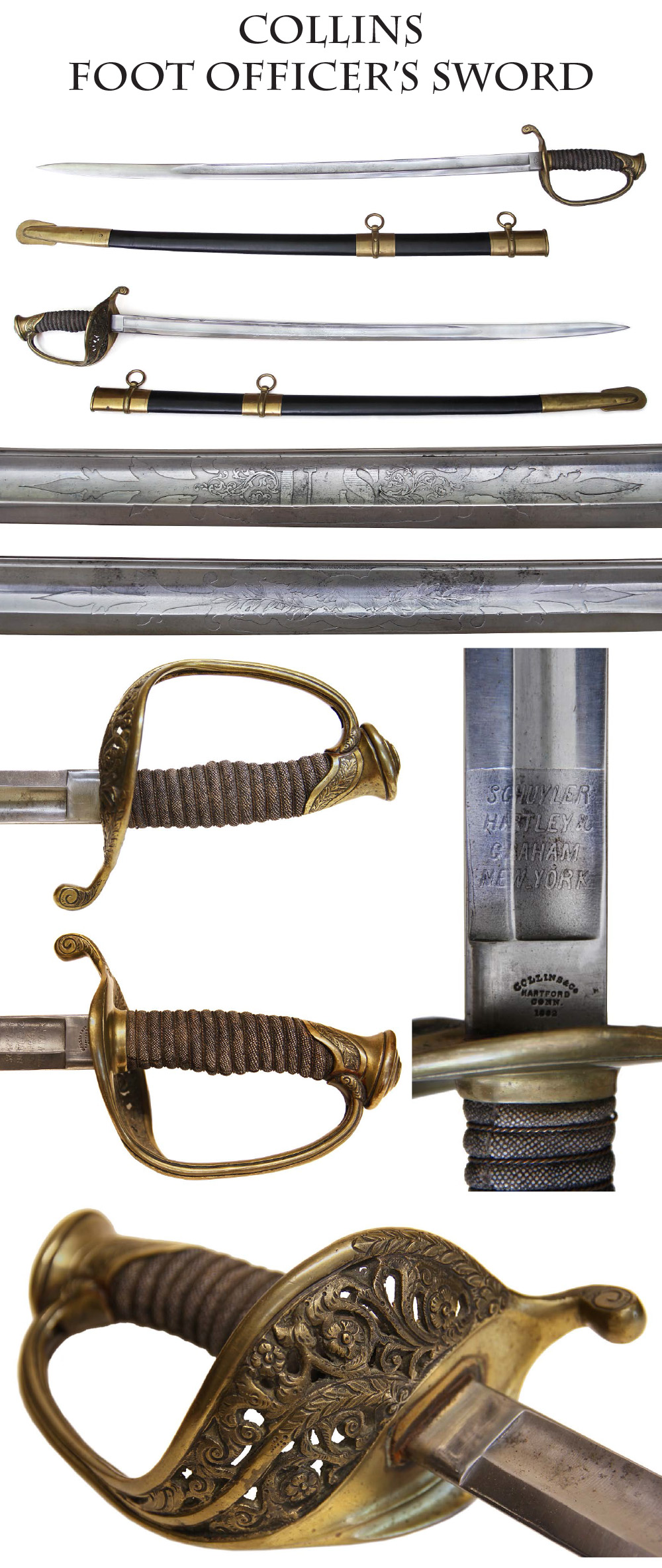
13-06-22 … 1850 Pattern Schuyler, Hartley & Graham Foot Officers Sword.
Very nice condition Civil War infantry officers sword and scabbard signed by the most famous of the New York City military goods dealers. This is the regulation pattern sword for Civil War infantry lieutenants and captains, worn not just on parade, but in the field and in battle. The officer who purchased this elected one special feature, choosing to have a metal scabbard rather than a leather one. The brass mounts of the scabbard and the hilt have a beautiful gentle patina. The leather covering on the scabbard is an absolutely PERFECT restoration, the inner sheath is original. I see a couple minor dings on the drag, otherwise about perfect. The hilt is in similar condition, all the sharkskin wrap and the brass binding wire. Everything still tight, and even the leather pad in place at the shoulder of the blade under the guard. Blade is bright, slightly muted, with the etching very legible. A US amid floral motifs on one side and a spread-winged eagle on the other, perched on branches and a ribband. Some slight graying in portions of the etching, but not affecting its visibility. Schuyler / Hartley & / Graham / New York etched low down on the blade on one side, just above the blade makers stamp on the ricasso: Collins & Co. / Hartford / Conn./ 1862, another well-known name in Civil War arms who supplied blades to SH&G for retail. This is several cuts above the usual quality and
condition 1850 officers swords out there and would look great with a nice officers sash.
As solid as a gold dollar. Could be used in living history
… $1,250.00… SOLD
Click Here to E-mail Us!
Call us @ 419-842-1863
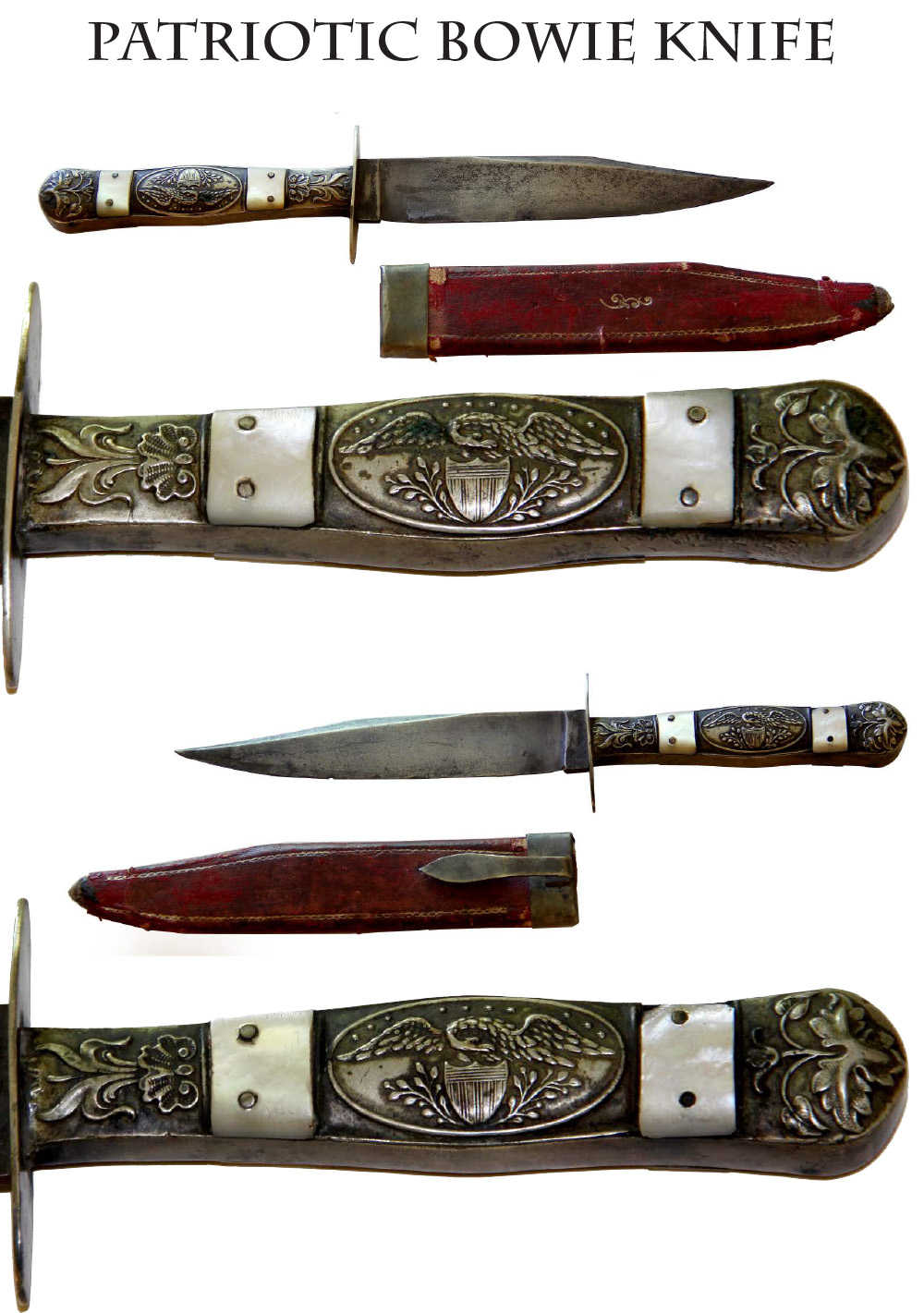
13-06-23 … Patriotic Bowie Knife with Original Red Scabbard.
Silver panel embossed grips with mother of pearl insets. The upper and lower sections are floral designs. The central panel on each side has a wonderful spread-winged US eagle curling its neck over a US shield with branches spreading below and a row of stars over the eagle. Nice untouched muted color to the silver. Oval German silver guard. Classic Bowie blade with false back edge. One minor nick on the edge, otherwise very nice. Untouched, uncleaned blade a dull silver also, with some graying and a smattering of dark spots. Unmarked ricasso. Original red leather or leatherette scabbard, with gilt embossed border decoration and a central flourish on one side. German silver throat in place with flat belt hook. Small metal tip is long gone, but the scabbard extends almost to the point. A very nice bowie of good form, excellent for an early western display or military display. The knife measures 10 3/4″ in length, with a 6″ blade. A classic Union Army soldiers knife
… $2,500.00
Click Here to E-mail Us!
Call us @ 419-842-1863

13-06-24 … Custer Michigan Cavalry Brigade Officers Oil Painted Escutcheon:
First Lieutenant William Hull, Sixth Michigan Cavalry! These wonderfully colorful service record escutcheons were purchased by veterans and proudly displayed to commemorate their wartime service. This one is not only in great condition and in its original frame, but belonged to an officer in one of the most famous of Civil War units imaginable, under the command of arguably the most famous of Union Generals: Custers 6th Michigan Cavalry. William Hull was a 21 year-old Detroit resident when he enlisted on 4/16/61 at Owosso, MI, and mustered in as a private in Co. A of the 1st Michigan Infantry on 5/1/61. This was a three-month unit recruited under Lincolns first call for troops by a proclamation of the Michigan Governor on 4/16/61, right after Fort Sumter. The volunteers accepted were from various militia companies in the state and were so quickly uniformed, armed and equipped that they reached Washington on May 16 and took part in seizing Alexandria on May 24. At First Bull Run they took a prominent part in the battle and lost 5 killed, 34 wounded and another 77 captured or missing. The regiment returned to Detroit for muster out on 8/7/61 and was quickly reorganized for three years service. Instead of continuing in the infantry, Hull was commissioned 2nd Lieutenant in Co. G 6th Michigan Cavalry 10/11/62. He made 1st Lieutenant 3/16/63, just in time for the Gettysburg campaign. In February, 1865, he was appointed Acting Assistant Inspector General of the 1st Brigade, 1st Division, and served until the day after Lees surrender, when he resigned, 4/10/65.
It would be pointless to try to recount all the action of the Sixth Michigan, and besides, one of the great things about these escutcheons is that the recipient supplied his full service record to the artist to be recorded on it. Suffice it to say, the Sixth Cavalry was one of the famous regiments early supplied with Spencer rifles and first saw heavy action under General Custers command at Hanover, Pa., June 30, 1863, and was thereafter in every major cavalry fight of the Army of the Potomac. It lost the incredibly high number of 121 killed in action and mortally wounded and another 214 wounded. That kind of loss is generally unheard of in a cavalry regiment. It was involved in the cavalry fight at Gettysburg and all the fighting of that campaign before and after. At Falling Waters it suffered 22 killed and 19 wounded. In 1864 it was at Todds Tavern, Hawes Shop, Trevillian Station and other well known battles, it served in the Shenandoah Valley, fought at Cedar Creek, Winchester, High Bridge, and other famous fights. Indeed, Civil War data had to set aside 122 entries for its engagements. I cant think of another regiment whose escutcheon I would rather have on the wall, and if you collect cavalry, Custer material, or the Civil War in general, this is probably the most interesting example you are likely to find. Colorfully done with the Arms of the United States at top, the eagle with arrows and olive branch, perched over a blue shield, quartered by a red cross with all of Hulls service record recorded in gold ink, his infantry ranks on the upper left, and his cavalry and staff ranks on the upper right, and the badges and flags of his various units in the lower quadrants, with his name and rank on a scroll beneath.
His record is fascinating to read on the escutcheon itself and offers that opportunity for much, much further research and enjoyment. I note only in passing that the escutcheon records that he was a sergeant in the infantry and also a first-sergeant in the cavalry, neither of which show up in the brief online records available, so there is a lot more yet to do.
Excellent condition. About the best of these you will ever find. Canvas and paint are perfect.
There is some damage to the gesso on the upper left corner of the frame
… $2,750.00… SOLD
Click Here to E-mail Us!
Call us @ 419-842-1863

13-06-25 … A Holy Grail Uniform Jacket:
Ultra Rare Schuylkill Arsenal Artillery Buglers Jacket. These grid-iron front musicians jackets are about the flashiest piece of Civil War uniform cloth available, and for my money, the artillery version is even flashier than the cavalry. It is the regulation deep blue waist-length shell jacket with 12 button front and piping on the cuffs, two back seams, bolsters, bottom edge, and down the center front and up the collar edges and at the two false button holes at either side of the collar. Very attractive. Retains the full original white muslin body lining and sleeve linings. SA stamp in the right sleeve lining showing this was a product of the Schuylkill Arsenal at Philadelphia and a numeral 1 signifying a size 1. There is also a number 13 stamped in the left sleeve, which is likely the number assigned to the individual seamstress who sewed this jacket. The Schuylkill Arsenal pieced out the sewing work to local women which helped support the widows and dependents of soldiers. There is one small hole in the lining of the upper right shoulder, otherwise about perfect save for some color run on the red trim on the cuff. Overall excellent condition. These coats were US Army regulation for the two buglers assigned to each battery of both field and horse artillery to communicate the commanding officers orders by bugle call. In rarity, these were only one or two percent of the artillery jackets made and they make quite a show in a Civil War collection whether you are an artillery enthusiast or not. Years ago Norm Flayderman told me that even back in the 1950s when he could buy original bales of Civil War artillery and cavalry jackets the musicians jackets were darn scarce then. He said that in every bale of jackets he would get only two or three with the grid iron trim. I forget whether the bales contained 50 or 100 jackets. I am pleased to be able to offer one, and included with the jacket are the original regulation issue shoulder scales shown on the shoulders
… $8,500.00
Click Here to E-mail Us!
Call us @ 419-842-1863
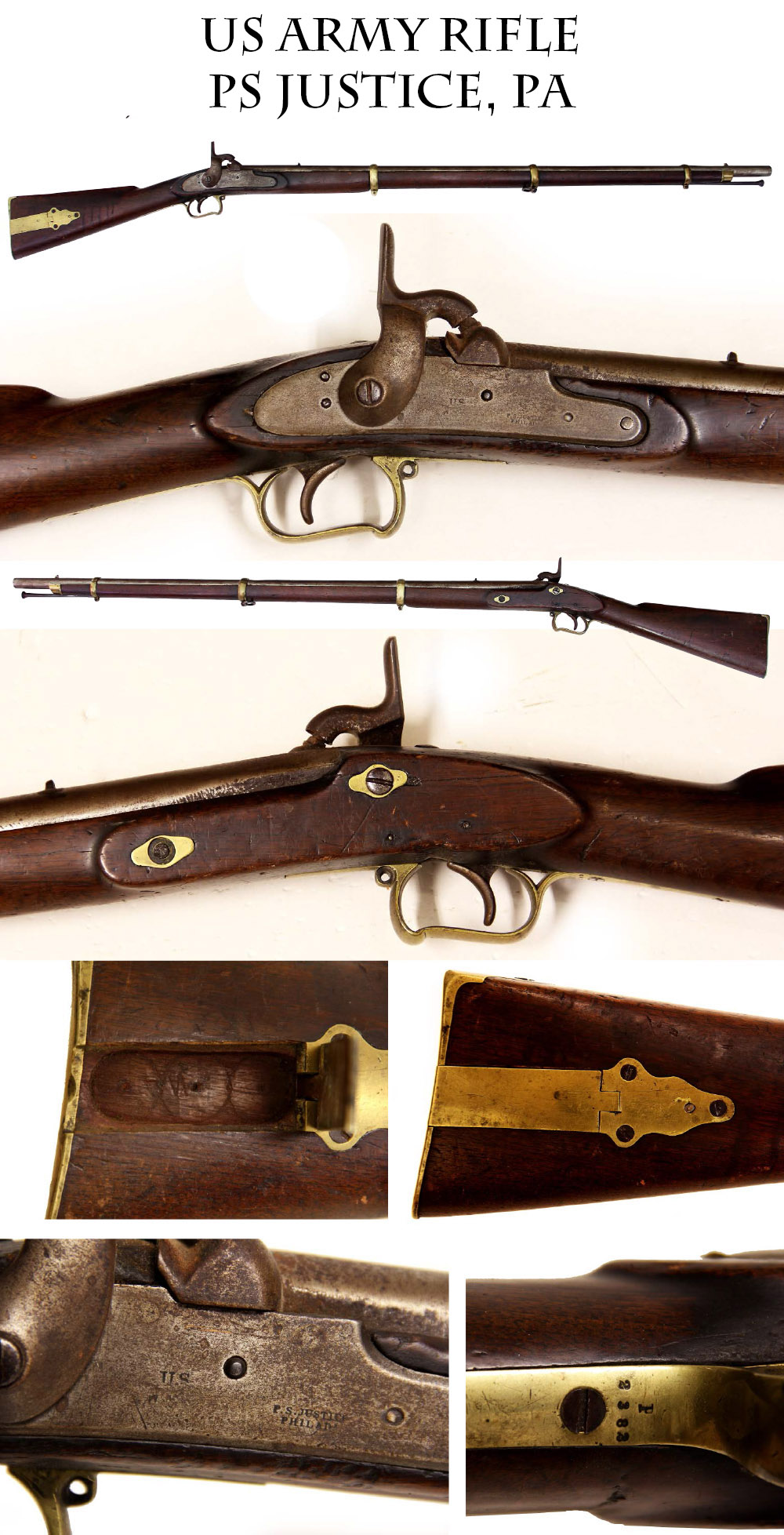
13-06-26 … P.S. Justice Rifle-Musket …
With the firing on Fort Sumter, P.S. Justice of Philadelphia raced to get arms into the hands of the early war volunteers, producing several variants of rifles and muskets. He turned out fewer than 5,000 guns in all, at first using a hodge-podge of surplus 1816 parts and then his own manufactured ones, but he got the job done and on time. This is termed the Type-III by collectors, brass mounted, with patch box and three barrel bands, .69 Caliber, and has the readily identifiable Justice double-curved trigger guard. US and PS Justice/ Philada. marked lockplate. Very nice looking overall. Lower sling swivel gone, as is the bayonet lug, otherwise complete. Ram rod is a button tip 1816 style as opposed to the tulip rod usually seen on Justice muskets. There is an even age toning on the barrel, silvery gray shifting to brown near the breech … Minor corrosion near nipple … vise marks on the left side of the breech … Lock, hammer and bolster are mottled gray with some brown undertones from faded casehardening. Mechanically good but no half-cock (full cock is fine), edges decent, just slight rounding from handling. Nearly invisible repaired MINOR crack where the wrist meets the breech. Forward lock screw is replaced with a non slotted screw or pin. That covers all the minor warts on this darn scarce musket. Nice medium patina on the brass. Marked with an M or W in the patch box which is a marking frequently seen on these, probably the surname initial of the stock maker. The use of a v-notch rear sight is unusual, but is like his Type-II musket. With Justice products, there are as many exceptions as there are rules. There is a serial number, 2382, stamped in the trigger guard. Many of Justices guns went to Pennsylvania troops, such as the 58th, 88th, and 98th PA Vols., and were the subject of some complaints at the time. However, students of American arms regard his products as worthy and well-intentioned. Justice succeeded in helping quickly arm troops in an emergency, and getting his weapons into the hands of troops by the end of 1861 … no mean feat. A solid, handsome, and scarce Pennsylvania musket
… $1,150.00
Click Here to E-mail Us!
Call us @ 419-842-1863

13-06-27 … Small Belgian Flintlock Muff Pistol:
I will let the photos do most of the describing here. A wonderful little bitty flintlock muff pistol circa 1825 measuring roughly five inches overall and being very high quality with engraved frame, silver wire and stud inlaid grip, and much appeal
… $1,295.00… SOLD
Click Here to E-mail Us!
Call us @ 419-842-1863

13-06-28 … I will let the photos do the describing here.
A wonderful little percussion muff pistol circa 1840 measuring
roughly six inches overall
… $595.00… SOLD
Click Here to E-mail Us!
Call us @ 419-842-1863

13-06-29 … Mexican War Dated Ames Model 1841 US Navy Cutlass:
These ’41 pattern naval cutlasses are among the scarcest of US nineteenth century swords to find. Here is a bit of background history… The first contract M1841 Naval cutlasses were delivered from Ames by mid-1842. The second contract is dated March 23, 1843, calling for 1,200 cutlasses and scabbards. Ames then received another contract dated September 31, 1844 for an additional 1,200 cutlasses and they were delivered in 1845. The final Bureau of Ordnance order was dated July 1, 1845 for 1,200 more. The last order was delivered in two parcels: 400 in July, 1846 and 800 in September. Our cutlass here offered is from this last contract. Oddly the 1846 specimens are all marked US as opposed to USN. This one is overall VG condition and the photos do a good job of showing the condition. Lightly cleaned. One side of blade is marked US 1846 R. Other side nicely marked N.P. Ames Cabotville. Quillon is inspected twice … “RC” and “JL”. This is a tight solid specimen with a solid quillon. I mention the quillon being solid because most 41 cutlasses have a crack at the base of the quillon. Nice example, (no scabbard).
… $895.00… SOLD
Click Here to E-mail Us!
Call us @ 419-842-1863

13-06-30 … Original Case and Accessories for a Colt “London Navy” Revolver:
If you have a nice London Navy this is exactly what you need. Totally original and containing all the needed accessories including the ultra rare silver bag style powder flask marked “Colt Navy Flask” and signed by Dixon. Also present is a near mint Colt navy bullet mold, mint wrench-screw driver, nice pack of cartridges, cleaning rod, oiler, bullets, and cap tin with most of the label. If you have a London Navy with finish on it… this will increase the value of your gun by far more than the cost of this set
… $3,500.00… SOLD
Click Here to E-mail Us!
Call us @ 419-842-1863
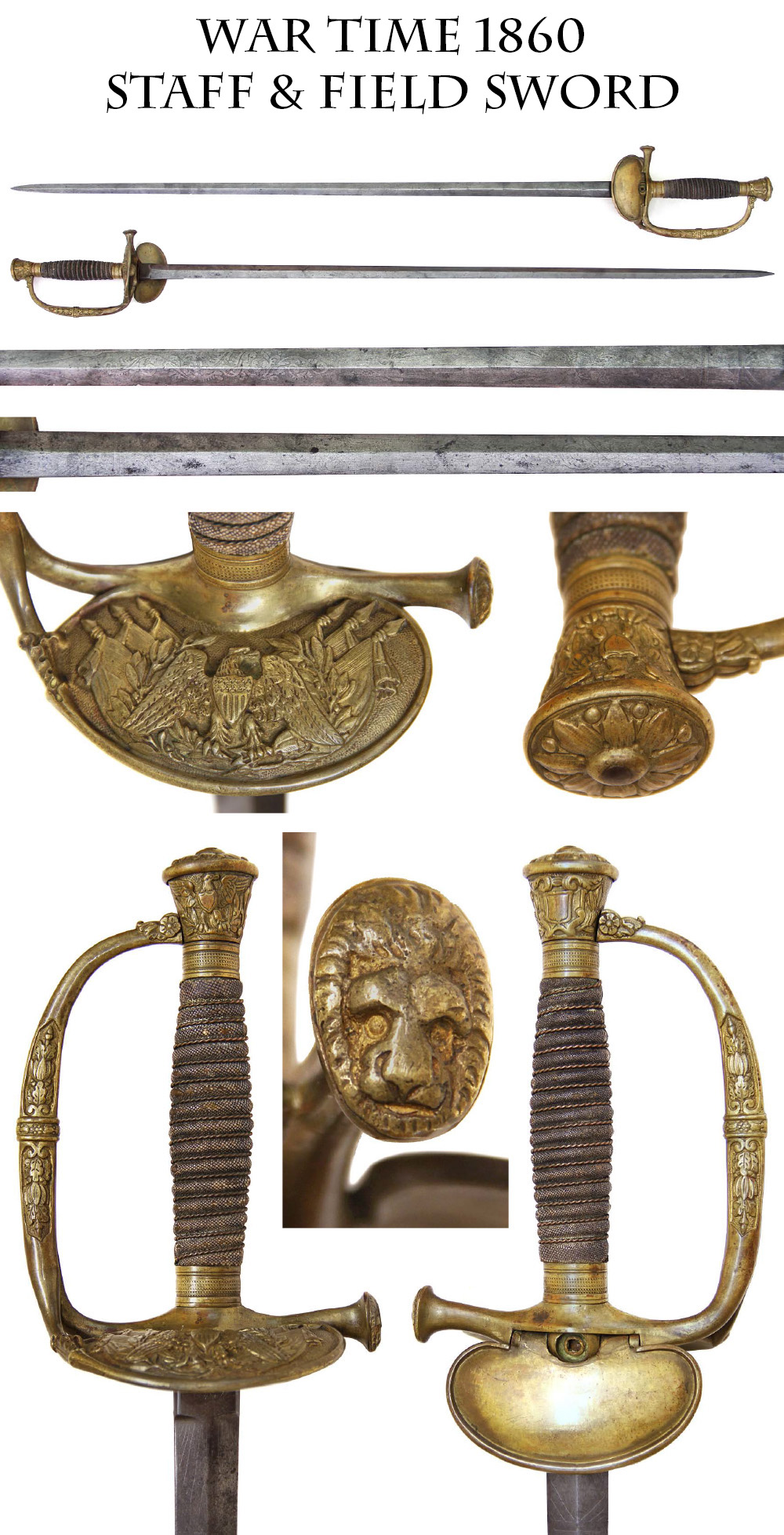
13-06-31 … War time M1860 Staff & Field Officers Sword:
This is the 1860 staff officers sword which is virtually impossible to find made pre 1865, a true rarity in military collectibles. This sword is etched with the US coat of arms, military trophies, and floral designs, and it bears a French blade makers touch mark on the ricasso. The knuckle-bow is cast with floral designs, and the guard has an eagle and arms on one side, with the opposite hinged clam shell guard being smooth. This sword is missing the small push-button ball, which helps keep the counter-guard either open or closed. The condition is about fine+. All you need to do is find a scabbard
… $695.00
Click Here to E-mail Us!
Call us @ 419-842-1863

13-06-32 … 1861 Dated US 1840 pattern light artillery saber and scabbard:
This pattern was introduced as a sidearm for mounted enlisted men in light artillery units. It was in service from the Mexican War through the Civil War and beyond. None were made after 1865 due to the huge number held in government stores when the Civil War ended. Overall VG++ condition. Has subtle age patina on the brass hilt, and a chocolate brown patina on the scabbard. The blade is overall gun-metal grey steel and it is evident that someone sharpened the blade a generation or so ago. This has a very good leather grip with just light handling wear and it retains all the original twisted wire wrap. Nicely marked U.S. / JH / 1861 on the obverse and AMES MFG CO./ CHICOPEE/ MASS. on the reverse. The Ames marking is very faint. If you want to know what the gunners carried who galloped into battle to support Custers cavalry charges in the war, this is the artillerymans saber. Very desirable with the early 1861 date
… $750.00
… SOLD
Click Here to E-mail Us!
Call us @ 419-842-1863
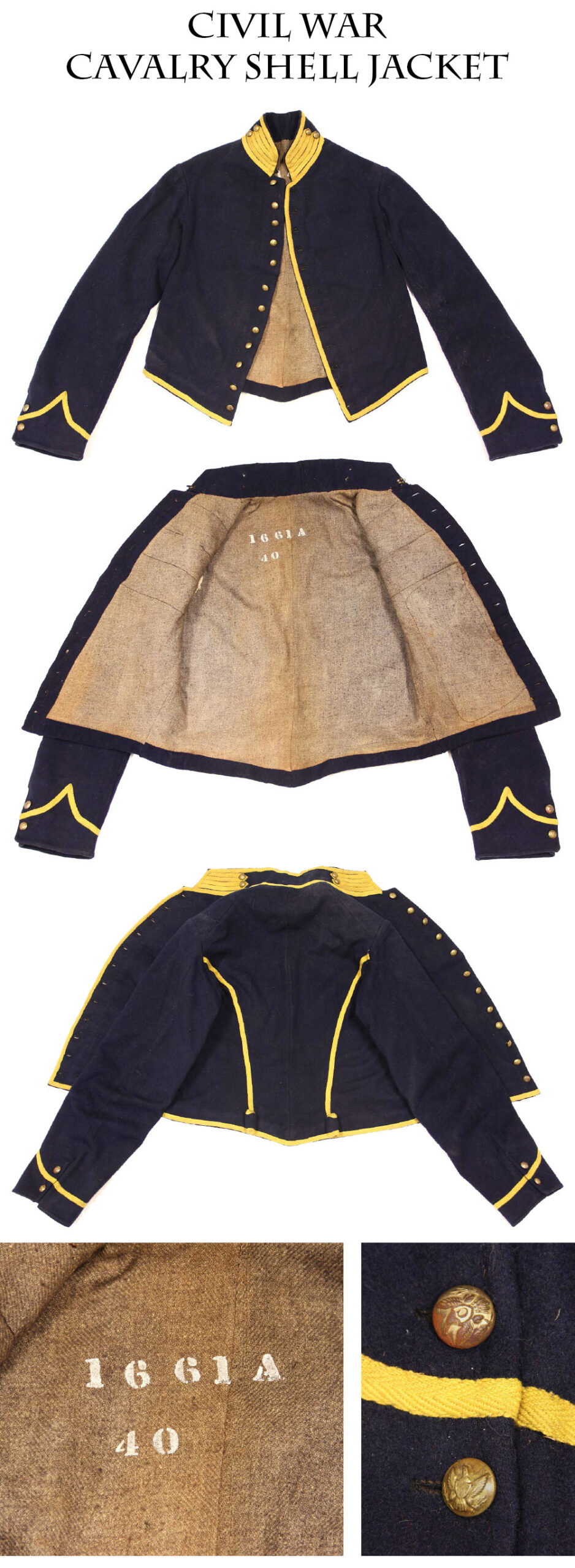
13-06-33 … Union Army Cavalry Jacket: Just like the good old days …
a mint unissued regulation Cavalry Shell Jacket. Superb condition. Full wool body lining, and full muslin sleeve linings. Size number 3 in right sleeve lining along with a Cinti inspectors mark.
All buttons present … Complete and near perfect. What else can I say
… $2,950.00… SOLD
Click Here to E-mail Us!
Layaways are Welcome
Need to split your order into multiple payments? No problem! A simple 20% earnest money deposit will hold your item for you.-acf
You can then pay it off in easy installments that fit your budget.
Read Terms Here
Items to Sell? Contact Us
I am always interested in buying ANYTHING from the American Civil War… Guns, Swords, Civil War Muskets, Knives, Uniforms, Flags, Medals, Badges, Diaries, Letters, Autographs, Buttons, photographs, tintypes, daguerreotypes, Insignia, Camp Items, Battlefield Relics, canteens, Drums, Etc… Call 419-842-1863 and ask for Dave Taylor.

